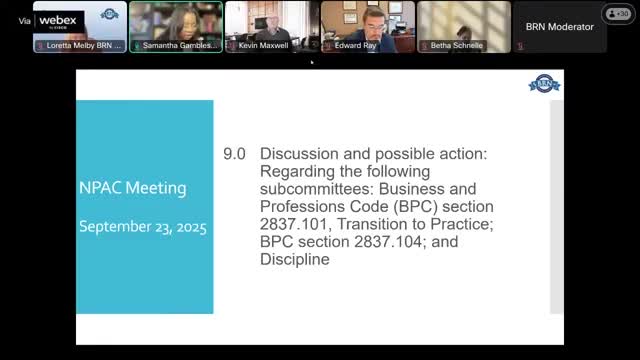Nurse Practitioner Advisory Committee Reviews Transition to Practice and Compounding Regulations
September 30, 2025 | California Board of Registered Nursing, Boards and Commissions, Executive, California
This article was created by AI summarizing key points discussed. AI makes mistakes, so for full details and context, please refer to the video of the full meeting. Please report any errors so we can fix them. Report an error »

The California Board of Registered Nursing convened on September 23, 2025, to discuss critical updates regarding the Nurse Practitioner Advisory Committee, focusing on the transition to practice and the implications of recent legislative changes.
The meeting began with a report from the Transition to Practice Subcommittee, led by Dr. Ray and Jan, who noted that while they have been monitoring legislative developments, no significant changes have emerged that would impact the committee's work. They emphasized the importance of staying informed about any new laws that could affect nurse practitioners (NPs) in California.
A key point of discussion was the recent legislative changes that have altered the transition to practice requirements for NPs. It was clarified that these changes were not initiated by the Board of Registered Nursing but were enacted through new statutory language passed by the legislature. This means that the Board must adhere to these new laws without the ability to amend them through regulatory processes.
The committee also addressed concerns regarding the attestation process for NPs transitioning to independent practice. Some members expressed apprehension about the lack of stringent verification standards for physicians who attest to the completion of required practice hours. This raised questions about potential misuse of the attestation process, particularly in light of past issues with similar practices.
Further discussions highlighted the need for clarity around referral processes for NPs. While the law mandates that NPs establish a referral plan for complex cases, it does not specify what this plan must include. This ambiguity has led to concerns about how NPs will navigate referrals in practice, especially as they transition to more independent roles.
The committee acknowledged the importance of collaboration between NPs and other healthcare providers, including physicians, to ensure effective patient care. Members suggested that guidelines from other states could serve as useful references for developing referral protocols in California.
In conclusion, the meeting underscored the ongoing evolution of nurse practitioner practice in California, driven by legislative changes and the need for clear guidelines. The committee plans to continue monitoring these developments and will address further concerns in upcoming meetings. The next steps include reviewing the attestation requirements and exploring potential regulatory updates to enhance clarity and support for NPs in their practice.
The meeting began with a report from the Transition to Practice Subcommittee, led by Dr. Ray and Jan, who noted that while they have been monitoring legislative developments, no significant changes have emerged that would impact the committee's work. They emphasized the importance of staying informed about any new laws that could affect nurse practitioners (NPs) in California.
A key point of discussion was the recent legislative changes that have altered the transition to practice requirements for NPs. It was clarified that these changes were not initiated by the Board of Registered Nursing but were enacted through new statutory language passed by the legislature. This means that the Board must adhere to these new laws without the ability to amend them through regulatory processes.
The committee also addressed concerns regarding the attestation process for NPs transitioning to independent practice. Some members expressed apprehension about the lack of stringent verification standards for physicians who attest to the completion of required practice hours. This raised questions about potential misuse of the attestation process, particularly in light of past issues with similar practices.
Further discussions highlighted the need for clarity around referral processes for NPs. While the law mandates that NPs establish a referral plan for complex cases, it does not specify what this plan must include. This ambiguity has led to concerns about how NPs will navigate referrals in practice, especially as they transition to more independent roles.
The committee acknowledged the importance of collaboration between NPs and other healthcare providers, including physicians, to ensure effective patient care. Members suggested that guidelines from other states could serve as useful references for developing referral protocols in California.
In conclusion, the meeting underscored the ongoing evolution of nurse practitioner practice in California, driven by legislative changes and the need for clear guidelines. The committee plans to continue monitoring these developments and will address further concerns in upcoming meetings. The next steps include reviewing the attestation requirements and exploring potential regulatory updates to enhance clarity and support for NPs in their practice.
View full meeting
This article is based on a recent meeting—watch the full video and explore the complete transcript for deeper insights into the discussion.
View full meeting
